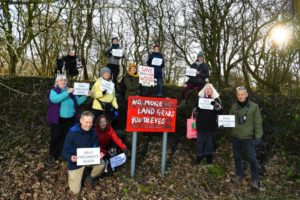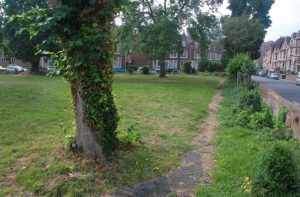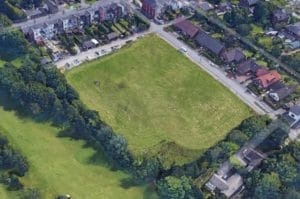Support us from £3/month
We deal with almost 1000 cases a year assisting communities, groups and individuals in protecting their local spaces and paths in all parts of England and Wales. Can you help us by joining as a member?
The think tank, ‘Centre for Cities’, which focuses on improving the economies of the UK’s largest cities and towns, published an article at the start of our lock down period, ‘How easy is it for people to stay at home during the coronavirus pandemic?‘ It concluded that the provision of public open space, such as parks, varies by location and that not all built-up areas can currently provide enough space for the inhabitants to exercise safely and maintain social distancing
Our case officer, Nicola Hodgson, offers an explanation for why there is such variation in provision and what options exist to improve the opportunity for people to enjoy the health and well-being benefits of being outdoors in urban areas.
Nicola observes that the present restrictions on public movement have highlighted the importance of the accessibility of open space that is near to where people live, in future it will be important to ensure provision of open space is adequately protected.
There are several reasons why there is a disparity across the country as to the provision of open space. First, it is important to remember that there is no statutory provision for open space. This means that there is no ring-fenced funding and local authorities, partly as a result of budget cuts, have less money to spend on the creation and long-term maintenance of open space. Alternative funding methods (for instance transferring land so that it is held by a charity), and disposals of open space and playing fields have also impacted on the amount of open space available. Local authorities (in accordance with the National Planning Policy Framework (NPPF)) do seek provision of open space in new developments but the on-going maintenance and long-term protection of such spaces is a problem and some developers require continuing payments from new residents to maintain the open spaces.

Freemans Wood Lancashire gained registration in 2019
The society encourages people to register land as a town or village green (TVG) more permanently to protect the land, or to have the land designated as a Local Green Space (LGS). Please follow the links for further information on these approaches.
There have been several reports on the benefits of open space on the health and social well-being of the public, for instance by Natural England, Mind and the NHS. In this difficult period of restrictions on people’s movements it is essential that people, in particular those in cities and those without gardens, have access to open space. Councils must be encouraged to keep parks open so that people can use them for their daily exercise as allowed under government guidance (ie once a day, social distancing, and household only). There has been a suggestion (in the Centre for Cities report) that golf courses should be available to for public use. Most golf courses are privately owned and so in general the public does not have the right to use such land. However, some golf courses do have public rights of way across them and people should be encouraged to use those public paths—and there is no reason by the golf-course owners cannot open their extensive land for public access during the pandemic.
The government has put out information about using local open space and we have highlighted this on our Covid-19 Update page. In places where there is less open space it is even more important that public rights of way remain open so that people have somewhere to walk.
It is helpful briefly to summarise the role of the National Planning Policy Framework (NPPF ) 2019, in England, in respect of open space generally, as this illustrates why there is a disparity in the amount of open space in different areas.
There is no national strategic plan for England. Wales does now have an overarching spatial plan and is working on a new national development plan.
The NPPF provides policies for sustainable development in England. For example, chapter 8 ‘ Promoting healthy and safe communities’, provides that planning policies and decisions should aim to achieve healthy, inclusive and safe places. Paragraph 91 advocates the need to provide high quality open space. Paragraph 92 argues that to provide the social, recreational and cultural facilities and services the community needs, planning policies and decisions.
There are no national standards for the amount of green space that should be provided, but there are some good practice examples for instance the Natural England ANGST ( accessible natural green space standards), due to be reviewed but probably now delayed, and Fields in Trust (FIT) standards.

Queen’s Crescent Gardens, local green space in Exeter, Devon
It is left to local authorities to make decisions about the amount and location of open space. Planning policies (as required under paragraph 96-97 of NPPF) should be based on robust and up-to-date assessments of the need for open space, sport and recreation facilities and opportunities for new provision.
The information gained from those assessments is then used to determine what open space, sport/recreational provision is needed.
It is through the Local Plan/Neighbourhood Plan process that open space provision is made alongside allocation of sites for development. However open space does not have absolute protection because (para NPPF 97) it can still be built on if the criteria are satisfied. For example, if an assessment has been undertaken which shows the open space is surplus to requirements or the loss resulting from a proposed development would be replaced by equivalent or better provision in a suitable (but note not necessarily the same) location, the protection can be challenged. Alternatively, if the development is for other sports and recreational provision, the benefits of which clearly outweigh the loss of the current or former use, there is room to relax the provision.
The society (please see further details on our website) has encouraged people to identify land during the plan process so that it can be designated as LGS under NPPF paragraphs 99-101. Once designated as LGS the land is protected in the same way as green belt land, but there are still exceptional circumstances when such land can be developed.

Whitehall Road Field Image Google Street View
Our website provides guidance on registering land as TVG. Such registration offers more permanent protection from development. Once registered it is protected under section 29 Commons Act 1876 and section 12 Inclosure Act 1857. It is possible for councils voluntarily to register open space as TVG to provide protection.
Our expert Nicola has already been quoted in a number of regional news stories triggered by the Centre for Cities report findings.
Milton Keynes ranks top for green space
Quarter of Southend residents living in flats sparking open space concerns
Here are some related articles describing our campaigns and comment pieces on this topic which you may find of interest:
Blackburn group win support of borough council for new Asset of Community Value April 2020
We press government to take urgent action to save parks February 2017
We welcome Kent County Council’s plan for country parks August 2017
We call for duty on local authorities to protect parks and green spaces September 2017
